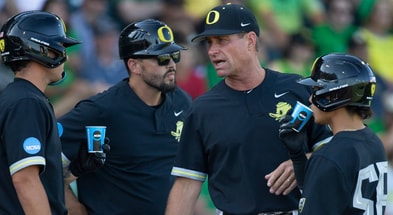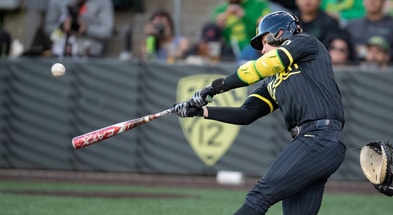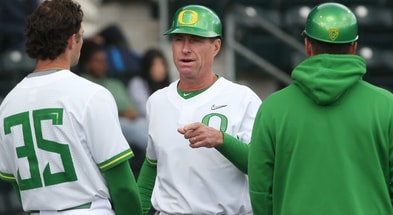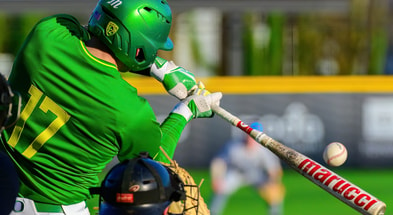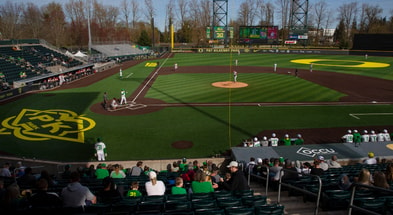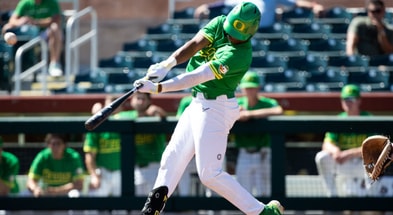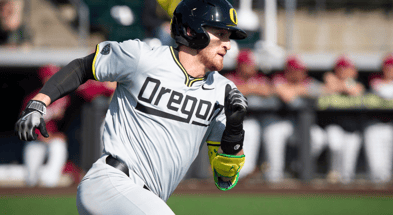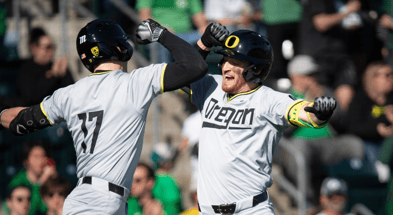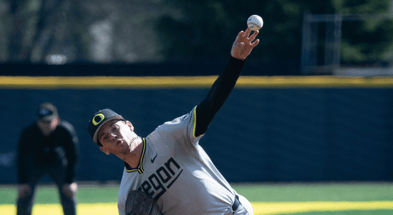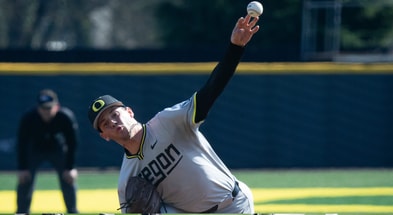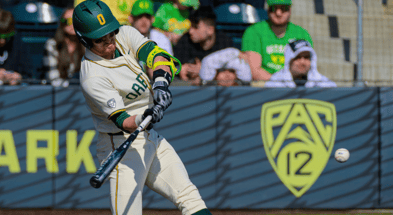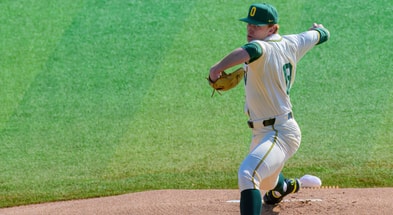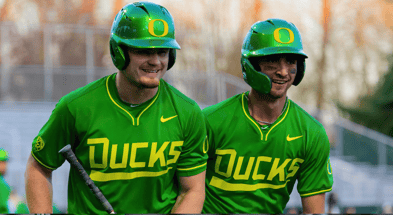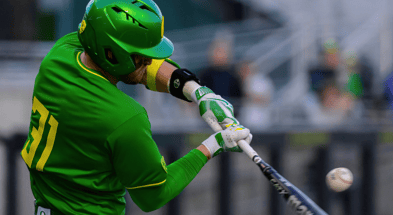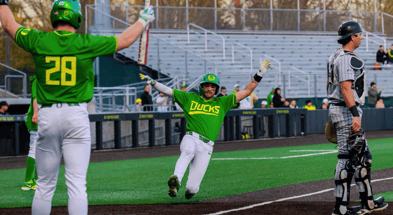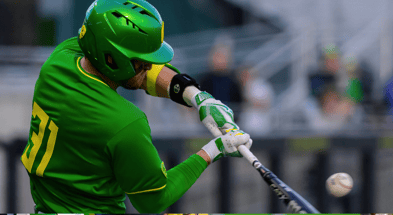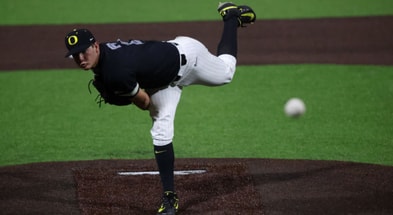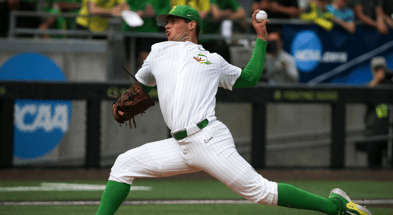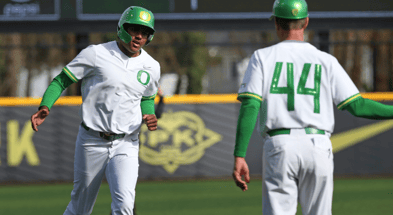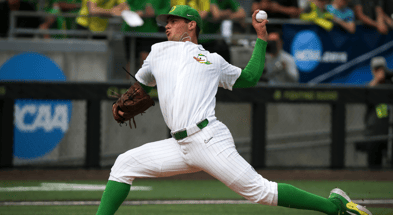Five takeaways from Oregon baseball's 2022 season

Depending on how you look at it, Oregon’s 2022 season can either be considered an overwhelming success, or a disappointing campaign that ended far sooner than it should have.
On one hand, the Ducks rewrote the school record book this year. Their offense was one of the best in the country, and the position player talent within the program is as good as any program in the Pac-12. On the other hand, Oregon will be watching the super regionals from home for the 10th straight year and has now been ousted on regional Sunday for two consecutive years.
So, what do you make of a year that has so many highs, but ended on an incredibly low note?
Here are five takeaways from Oregon’s 2022 season, and what it means for the program moving forward.
Record-setting offense
This season, Oregon broke school records for:
- Batting average (.310, previously .306)
- Home runs (72, previously 56)
- RBI (416, previously 334)
- Runs (452, previously 379)
- Hits (670, previously 624)
- Total bases (1,041, previously 864)
Those numbers are even more impressive considering the level of pitching the Ducks were up against on a day-to-day basis. The Pac-12 is littered with top-end pitching talent and featured at least five hurlers this season who have a decent shot to be top-100 MLB draft picks during their careers.
To hit .310 against consistently elite pitching is an incredible accomplishment.
Oregon leaned on a large collection of draft-eligible position-player talent this season, and it’s possible that the lineup will look quite different in 2023.
But the rapid improvement that the offense has displayed over the past two seasons is an indicator that the gaudy hitting numbers could be a constant in Eugene for years to come.
Direction of the program
It’s impossible to ignore what Mark Wasikowski’s Oregon squad did this season, especially considering where the program was when he inherited it on June 11, 2019.
When Wasikowski took over for former head coach Goerge Horton three years ago, the Ducks had just finished a campaign in which they finished 10-19 in Pac-12 play. They finished ninth in the conference and were outscored 382 to 321 over 56 games.
This year, Oregon outscored its opponents 452 to 320.
The 2019 Ducks had just two players finish with an on-base-plus-slugging percentage better than .800 — Spencer Steer (.958) and Gabe Matthews (.844).
This year, eight of Oregon’s everyday starters put up an OBPS greater than .800. Five players finished at .850 or better, and three players (Drew Cowley, Anthony Hall, and Brennan Milone) finished at .950 or higher.
Those type of numbers don’t happen by accident. Two of the team’s most productive hitters — Cowley and Milone — were transfers who had faced struggles at their previous stops before putting up video game-type numbers during their respective first seasons in Eugene.
In just three years, Wasikowski and his staff have completely changed the identity of the program and shaped it into a destination that could attract the top hitters in the country.
Pitching struggles
You can’t mention Oregon’s offense without also acknowledging the disastrous season that the program’s pitching staff experienced.
For as good as the Ducks were at the plate, they were just as poor on the mound. They finished the year ranked 67th in the nation with a 4.74 ERA. They yielded 4.58 walks per nine innings, which ranked 166th in the nation.
Simply put, Oregon’s inability to throw strikes killed any chance it had of contending on a national stage in 2022.
Wasikowski and pitching coach Jake Angier will undoubtedly do some soul-searching in the offseason and try to pinpoint what went wrong. They faced a difficult task in replacing their entire starting rotation from the previous season, and the addition of Adam Maier, a top-100 MLB Draft prospect, was intended to provide the Ducks with a bonafide ace.
But Maier made just three starts before being shelved for the season due to injury. The rest of Oregon’s starting pitchers either regressed or failed to consistently perform when given the chance.
Top 10
- 1New
Roster Limits
Judge makes monumental decision
- 2Hot
Todd McShay
Releases Final Mock Draft
- 3
Steve McMichael
Hall of Famer, Texas legend passes
- 4Trending
Madden Iamaleava
Arkansas demanding $200K
- 5
Intel-based Mock Draft
Peter Schrager shakes it up
Get the On3 Top 10 to your inbox every morning
By clicking "Subscribe to Newsletter", I agree to On3's Privacy Notice, Terms, and use of my personal information described therein.
It wouldn’t be surprising to see a flurry of transfer portal additions on the pitching front this offseason.
Draft-eligible players
Oregon is going to lose a lot of talented players to the Major League Baseball Draft this summer.
This year’s Draft is 20 rounds and will run from July 17-19. Oregon’s starting shortstop, Josh Kasevich, has almost certainly played his last game as a Duck. He’s a consensus top-100 prospect who possesses an elite glove and is nearly impossible to strike out.
Anthony Hall is just a sophomore in terms of eligibility, but has played three college seasons and really boosted his draft stock in 2022 while posting a .640 slugging percentage. There’s a good chance he is drafted within the first five rounds.
Tanner Smith, Drew Cowley, and Brennan Milone are all draft-eligible players who posted eye-popping numbers this season. Maier was a consensus top-100 prospect prior to his injury, and it’s been reported that he is likely to return to Oregon in 2023.
We’ll find out in a little under two months exactly how much attrition the Ducks experience through the Draft, and it’s always a sign of a healthy program when Major League teams come calling.
But it could be the case that Oregon needs to replace multiple impact starters…
Continued talent development
… Which is why it is crucial for Wasikowski and his staff to build on this year’s momentum. During the first three years of his Oregon tenure, Waz has shown a tremendous ability to acquire talented players and get the most out of them once they arrive in Eugene.
There’s no reason to believe that won’t continue to be the case.
As a true freshman, Jacob Walsh looked like a superstar in the making early in the season before hitting a freshman wall in May. Colby Shade flourished into a dynamic five-tool player during his first year as Oregon’s starting center fielder and was batting out of the No. 2 hole for the Ducks by the time the season ended.
Freshman Bennett Thompson took hold of the starting catching job late in the regular season and will only continue to get better.
The cupboard is far from bare in terms of young, position player talent. As for the pitching staff, the growing pains that took place in 2022 could pay major dividends in the future.
Closer Kolby Somers and reliever Dylan Sabia are the only pitchers who have exhausted their eligibility. Rio Britton, R.J. Gordon, Isaac Ayon, Logan Mercado, and Andrew Mosiello all flashed massive talent as true sophomores but struggled to consistently produce. Jace Stoffal emerged as Oregon’s most reliable starter over the final month of the season, and the coaching staff is very high on freshman Tommy Brandenburg.
That group gives the Ducks a promising nucleus of arms to build around.
If Oregon can replace the production it loses at the top of the order and find a way to add a couple of top-end arms, there’s no reason the Ducks can’t compete for a Pac-12 title and finally get back to the super regionals in 2023.

